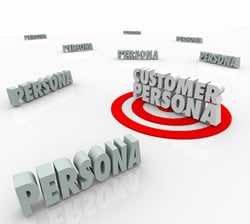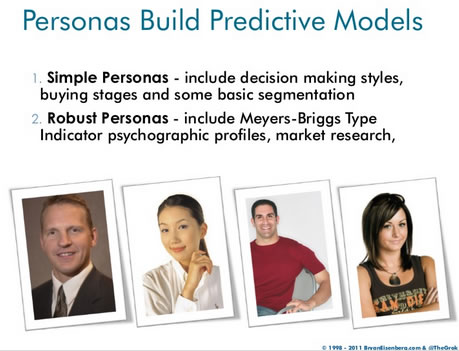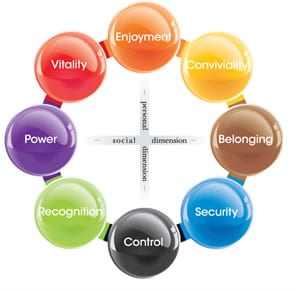 Using personas in (online) marketing is not new. Among others conversion optimization practitioners, user experience designers, web developers and usability experts have been using personas for ages. By defining personas we put ourselves in the shoes of a “typical” target person and define processes by empathizing with them in a very detailed way so we can ‘convert’ them, directly or indirectly. In marketing we mainly look at buyer personas. An overview of some persona and buyer persona models.
Using personas in (online) marketing is not new. Among others conversion optimization practitioners, user experience designers, web developers and usability experts have been using personas for ages. By defining personas we put ourselves in the shoes of a “typical” target person and define processes by empathizing with them in a very detailed way so we can ‘convert’ them, directly or indirectly. In marketing we mainly look at buyer personas. An overview of some persona and buyer persona models.
Working with buyer personas until further notice remains very important and is done in content marketing and several integrated marketing, customer experience optimization, conversion optimization and touchpoint-related exercises. However, it’s not perfect. There is a difference between putting yourself in the shoes, regardless of your degree of empathy, of the customer and really knowing what each individual wants in actual situations. So, we test, improve and ideally involve people from our different ‘target segments’. The use of buyer personas also evolves (as the behavior and needs of people evolve and you thus need to revalidate your existing personas again now and then).
Before you start: what do you need to know?
Before actually starting to fill in the blanks that you need to “build” your personas, it’s important to know what those blanks are. Or in other words: what do you NEED to know so that you can provide the proper content and services to your customers in function of what they really want you to know (before considering doing business with you).
Look at it this way: working with buyer personas first and foremost is meant to make your marketing more buyer-centric by having a very informed – and validated – view on your customers. So, start with the essential questions you need to answer, as close as possible to your prospective customers, goal/brand and the intersection of both.

We fully agree with Ardath Albee, for instance, when she says that it’s probably more interesting to know if if you know your consumer has two kids, lives in an upscale zip code in the suburbs, and drives a Porsche Cayenne in B2C marketing than in B2B marketing where you want to look at other questions (it’s more about complex buying journeys, decisions with multiple stakeholders and typical go-to-market models that you generally find in B2B, although you can also find them in B2C and often B2B can be simple too, so it’s not a strict distinction nor about B2B versus B2C, it’s always people-to-people). When you’re working with personas in a context of customer experience and customer journey mapping, it might make more sense to work with emotional/psychological elements, given the emotional dimension of the customer experience. In other words: there is no one-size-fits-all approach for every purpose and context.
As we move towards a further personalization of marketing interactions, including increasing needs for personalized information and getting the right ‘content’ at the right time across the right channels and touches, it might seem that working with personas is ‘old school’. But it’s not, on the contrary, even if with real-time approaches based on Big Data analytics and a more personalized digital reality, things might change faster than we think. Yet, despite all technological evolutions, what really matters is that you know your customer and I really mean: know your customer.
The foundation for any marketing – content or otherwise – is your target audiences, buyer personas, customer profiles, industry segments – whatever you want to call this directed and in-depth research and depiction of who buys what from you and why. (Ardath Albee, interview on buyer-centric content marketing and personas).
Working with buyer personas forces you to take a deep dive into the typical needs and behavior of your customers, even if they are ‘segmented’, and to look at what influences them across all their decisions. Buyer personas are examples of people you want to convince and influence so they take action. Action is only taken if the value we offer matches that of the intent of people across their multiple touches.
When developing websites we also use personas but on top of buyer personas these can include other characteristics or even ‘types’ of people that would visit your website. Think about potential future employees, for instance, or journalists, to name a few. However, stick as much as you can to buyer personas. In the end, everyone is a customer in the broadest sense. It’s the customer journey and life cycle that matters in most marketing and content marketing. By mapping buyer personas, stages in the buyer’s journey (pre-purchase, post-purchase, etc.), touchpoints, content needs/gaps and KPIs we can then bring everything together.
Tony Zambito’s 5 buying behavior phases for personas
Tony Zambito distinguishes 5 buying behavior phases of the buying cycle, which should be addressed in personas:
- Audience behavior. With a clear link to content marketing, Tony uses these for customers who are currently not in the market for your products, solutions, services, etc. Awareness and the inclusion of influencers matter here.
- Lead behavior. Here we have an interested buyer who has a different behavior than the “audiences. This changes the goal perspective. In a sense, the goal becomes a bit comparable with the good old “acquisition” stage of Jim Sterne and Matt Cutler’s model where we try to bring reached people who are interested in the influence sphere of the business. They’re out there, ready to buy: reach and acquisition.
- Buyer behavior. Here buyers are actively engaged in the buying process as Tony puts it and we’re in the real classic buyer persona model. What do we need to know about the buyer in order for him to become a customer.
- Customer behavior. The sale is done (or the buy happened if you prefer it that way) and the behavior of the actual customer in the early stages can help everyone involved in onboarding, supporting and following up the customer.
- Brand behavior. Here Tony refers to the re-emerging discipline of brand management and the brand’s promise. We’re largely talking about advocacy indeed.
An overview of persona and buyer persona models
Personas, whether buyer personas or not, represent how different segments will interact with you. As said, in each step and across each touchpoint they take decisions and by giving them a name, face and personal story as representatives of your typical buyer segments, etc. you take that narrative when looking at every decision. It’s clear that content is essential in taking decisions and persuading people to make them. From a content marketing personas perspective we add this additional mapping layer of auditing content needs. It’s not only important to identify buyer personas. In fact, we even “interview them” (since before we even talked about content marketing and marketing automation, two phenomena that fit in a customer-centric and integrated view and gave a new ‘impulse’ to using buyer personas).
There are different models that have influenced the way marketers defined personas, including psychological models. In online marketing and this post we mainly look at rich personas, with that additional content mapping twist.
Rich personas are those fictive people in our ‘target’ groups that get a name, a face, a psychological, relational profile, etc. as explained previously And they are buying personas. Nevertheless, let’s also look at other models that are sometimes used in a marketing context, including social, etc. to have a full picture.
Personality and psychology models
Let’s start with some that are deeply rooted in psychology.
The functions and types of Jung
In developing his own psychoanalytical views, Carl Gustav Jung, defined two “primary” rational judging functions: thinking and feeling. He also found two irrational perceiving functions, being sensing and intuition. He further refined this by adding that these functions are either expressed in an introverted or extraverted form. This resulted in eight psychological types.
The Myers-Briggs approach
Myers Briggs is based on the mentioned typologies of Jung and is really a psychological assessment that aims to understand psychological preferences. The so-called Myers-Briggs Type Indicator is composed of 16 psychological types. They are expressed by combining four letters for each type.
The letters that are used in these combinations are E (extraversion), S (sensing), T (thinking), J (judging), I (Introversion), N (Intuition), F (Feeling) and P (Perception). Obviously, you can’t combine them all since extraversion, for instance, is the opposite of introversion. The same goes for S and N, T and F, and J and P.
Other psychological models
These psychological models have been used for persona development as well, just as many others have, such as the 16 personality factors of Raymond Cattell, the so-called “Big Five” and the four (and five) personality models.
It’s interesting to study and understand them but to be honest; I don’t use them (also since I have a fundamental problem with categories and labels anyway). “Translate” them if you want but in the end, you will only work with probably four personas anyway (maybe up to six).
Behavior and buyer persona models for marketing
Here are some more pragmatic models that are used in marketing, some for specific marketing tactics.
The buyer personas model of Bryan Eisenberg

Bryan Eisenberg has an actionable model that is based on buying decisions and behavior. It also corresponds with the four typologies Jakob Nielsen found in heatmaps and the usability tests he conducted, as Bryan found out (and as you can discover in the presentation below Bryan used during a great keynote at one of our events) .
Bryan Eisenberg identified four buyer personas, that are based on two axes: pace (quick or deliberate action) and bias (logical and emotional decisions). The resulting personas are called competitive (quick and logical), spontaneous (quick and emotional), methodical (deliberate and logical) and finally humanistic (deliberate and emotional).
Some traits of these four buyer personas:
- The Competitive: these are logical fast thinkers that are very goal-oriented and also like to take quick decision. They’re often first movers and early adopters and like to own something first. They respond well to offers and don’t need too much information.
- The Spontaneous: these are also fast thinkers but they are more ’emotional’. If they feel good about a decision, they don’t wait long to make it. They also respond well to offers and promotions but need more reassurance, reviews and ’emotional’ information such as images and specific types of content. But don’t expect them to read it all. They typically scan content.
- The Humanistic: like the spontaneous they are more ’emotional’ but they think and act much slower. They like service, care about relationships, like to know what others think (reviews) etc.
- The Methodical: they are also slow but in a more logical way. They are the really informed buyers, knowing what they want and what they want to solve with it. They go for facts and will typically do a lot of research (and thus spend the necessary time looking at factual content) before buying/deciding. This is the hardest kind of buyer to ‘seduce’ with promotions.

A small note: Bryan’s model is a proven one but do take into account that most human decisions have a emotional component that is highly underrated. In fact, even seemingly rational decisions in the end are deeply rooted into our emotional life: the subconscious is far stronger than most of us even begin to realize.
B2B buyer persona models and resources

There is a bunch of people who do a lot of great work on – mainly B2B-oriented buyer personas. Check them out, as well as their models.
- Tony Zambito dedicates a lot of his time and effort on analyzing the B2B buyer’s behavior and buyer persona models and evolutions in an ever changing landscape. In a blog post on the state of buyer personas 2014, he gives a nice overview and explains his notion of buyer foresight. Tony also developed the trademarked Buyer Persona Canvas.
- Adele Revella runs the Buyer Persona Institute and offers persona masterclasses. Don’t miss any of her blog posts such as ‘6 reasons to start using buyer personas now‘.
- Finally, a special mention for Ardath Albee who often writes thought-provoking blog posts about (B2B) buyer personas, covers the topic on her blog Marketing Interactions and also developed a (B2B) persona ‘tool’ you can use if you want to get started, Up Close & Persona™. Check out this interview with Ardath on buyer-centric content marketing and personas.
The human motivations approach by Synovate Censydiam (now part of Ipsos).

This is not a persona model as such, but you can work with it to create personas that suit your goals and correspond with the traits of your ‘target’ groups. It is based on motivation and intent (see the flip book “True Colours: Using Human Motivations to inspire Marketing”) with two axes: personal and social dimensions.
The model is developed for marketing and branding purposes and defines 8 motivations. Is it perfect? No. However, it’s an actionable model as well.
Motivations are obviously essential in taking decisions and they are mainly emotional (although we explain them rationally). Most persona models I have seen, based upon it, distinguish four personas. Indeed, just like Bryan’s.
Digital footprints, interactions and data
This brings me to other ways that are more closely related to actual behavior and the ways in which people interact with businesses, both online and offline. By measuring, testing and aggregating data, you can define personas when moving forward in your digital marketing or touchpoint strategy.
How people interact, their buyer’s journey, how they decide, their customer life cycle and why/how they act, click, share, like, recommend and get out their wallet in the end is what marketing and thus personas should be about.
Images purchased under license from Shutterstock

